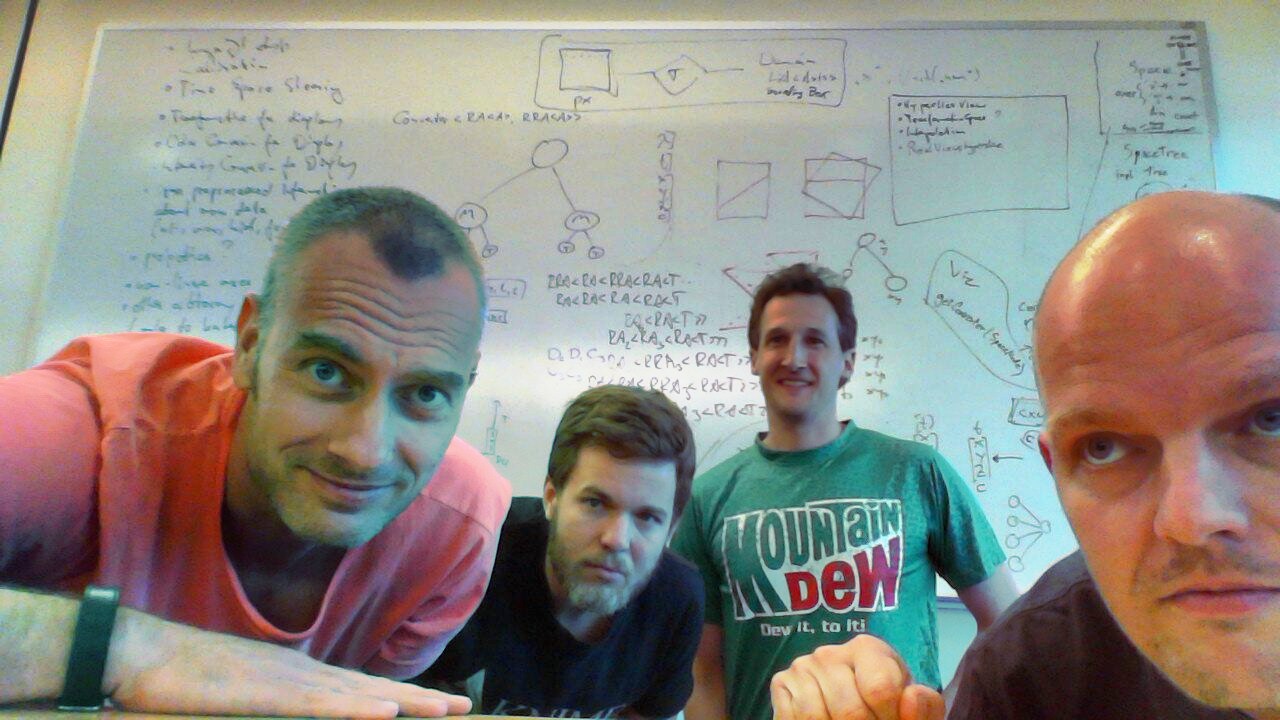
ImgLib2 hackers, from left to right: Stephan Saalfeld, Christian Birkhold (Dietz), Curtis Rueden, Tobias Pietzsch.
From Sunday, June 19, 2016 through Tuesday, June 28, 2016, Stephan Saalfeld at HHMI Janelia in Ashburn, Virginia hosted Tobias Pietzsch, Curtis Rueden and Christian Birkhold (Dietz) for a hackathon to improve the core ImageJ2 data model.
Timeline
The following chart illustrates when everyone was present:

And Kyle Harrington stopped by on the afternoon of the 23rd to discuss some issues for a bit.
Discussions and progress
We spent the first couple of days discussing use cases and requirements for core ImageJ2 metadata-rich image structures.
Some of the needed features we considered:
- ImageJ 1.x style calibration
- Time space shearing
- Transformations for display
- Color conversion for display
- Intensity conversion for display
- Store preprocessed information about raw data (e.g.: min, max, histogram, features, …)
- Projections
- Non-linear axes transformations (e.g.: log)
- Other arbitrary transformations (e.g.: polar to cartesian)
- Some informative strings (metadata)
The central use cases we used as litmus tests for our ideas:
- Interpolate differently across different dimensions of an image (e.g.: treat XYZ as continuous with Lanczos, but time as discrete with nearest neighbor or maybe 1D linear.
- Register 2D tiles into a larger 2D image, a la TrakEM2.
- Register 2D planes over time (e.g.: correct for shaky cam).
- Time skew over samples: each plane/scanline/pixel can have a physical timestamp, which could be taken into account somehow, although in practice doing so is very rare.
We spent quite some time considering how to create a unified data structure (SpaceTree? :-) which would keep multiple images grouped into some tree- or graph-like structure, with attached transforms, in a way which handled all of the above use cases and more.
Ultimately, we concluded it was too difficult to design such a data structure in a vacuum, so we instead opted to start coding individual use cases using ImgLib2. We came up with a design which provides: A) a container for metadata-rich images, with individual metadata elements sensitive to Views manipulations; and B) a scheme for “grooming” these metadata-rich images into increasingly useful data structures depending on the use case.
Metadata-rich containers
We invented MetaViews, a class analogous to Views but for metadata elements. These elements are then aggregated into a MetaSpace, which provides mutators and accessors for working with the space. For example, you might attach a physical calibration to a spatial axis, or a custom variable-width timestamp to each point along the time axis.
On top of this, we are actively developing a (tentatively named) RichImage structure, consisting of image pixels (e.g., a RandomAccessible) together with a MetaSpace which describes it. The SCIFIO library will be updated to produce a Dataset, a collection of RichImage elements, which are populated with elements directly from the source data format.
Image enrichers
For the various use cases above (e.g., registration of tiles in a larger space), we will have a pipeline which calls ImageInspector plugins that examine the RichImages and decide whether they can be improved with available ImageEnricher plugins. (Again: these are working names only.) For instance, the Dataset image collection might consist of a bag of 2D tiles with associated affine transforms; a MosaicEnricher could then apply those transforms virtually to offer the larger 2D mosaic image as a RandomAccessible which returns lists of tile values at each sample. A FusionEnricher could operate on any RandomAccessible which returns a list, blending the values of that list using a given Converter. (In practice, the enrichers will very likely be more general than these examples, but hopefully they serve here to illustrate some of the possibilities.)
Source code
Current work on these data structures can be seen at:
There is also an experimental repository for the hackathon at: